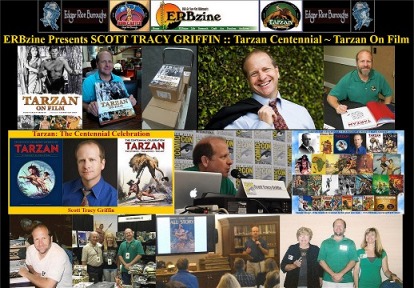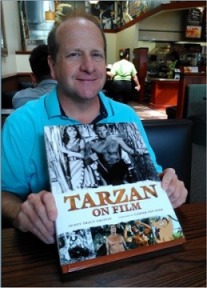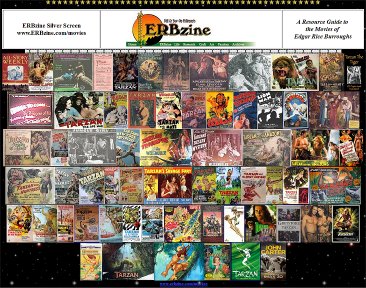Celebrating the Tarzan Film Centennial #92
 .
.
1.The autobiography of silent film actor and stuntman Joe Bonomo
2. Joe Bonomo and Louise Lorraine in the Universal Pictures serial
"The Great Circus Mystery" (1925)
In his autobiography “The Strongman,” silent film actor
and stuntman Joe Bonomo claimed that he was initially cast as the apeman
in Universal’s “Tarzan the Mighty.” On the third day of filming, a vine
snapped during a swinging stunt, and he hit the ground, compound-fracturing
his leg and injuring his hip. Seven weeks in the hospital ended his Tarzan
aspirations, and the hip injury eventually ended his stunt career.
It’s not clear from his account when this occurred
(according to some internet sites, the fracture occurred on the set of
the Swiss Family Robinson serial “Perils of the Wild,” shot in 1925); Bonomo’s
part in the Tarzan role went unmentioned in the trade papers of 1928, which
noted on May 19 that Frank Merrill had been cast in the role shortly after
the serial’s casting call was announced.
Born Christmas Day, 1901 to Albert and Esther Bonomo
(who had emigrated from Turkey and sold Bonomo Turkish Taffy on Coney Island),
Joe was a six-sport star in high school who later played for the Hiltons,
Coney Island’s professional football team. In 1921, he entered an amateur
wrestling tourney in New York City, losing the championship bout to Nat
Pendleton, who went on to compete in the Olympics and work on camera as
an actor. Bonomo began competing as a professional wrestler under the name
Joe Atlas, and was undefeated in more than 100 bouts. He worked out at
the famed Bothner’s Gym in New York City, training under pros including
Jim Londos, Ed “Strangler” Louis, and Bull Montana.
Friends with Charles Atlas and a fellow pioneering
physical culturist, Bonomo entered a “New York Daily News” contest to find
a Modern Apollo (a precursor to today’s Mr. America contest) and won a
Hollywood contract to appear in “Light in the Dark” (1922) over 5,000 applicants.
Despite his hard stuntwork, his role was an uncredited extra role. A stunt
injury later put Bonomo out of the running for the “World’s Most Perfectly
Developed Man,” a contest won by his friend, launching Atlas’s career as
a muscleman.
The industrious Bonomo soon found more stunt work in
films; one of the first stunts he did in “Hurricane Hutch” (1921) was to
jump a motorcycle from a pier onto a departing ferry. Bonomo later set
a motorcycle jump record of 126½ feet. He could straighten horseshoes,
bend iron pipes into the letters of the alphabet, and squat lift a car
full of people in a specially constructed harness. He dove from a flying
plane into water without a parachute and slid 150 feet down a rope for
Lon Chaney in Hunchback of Notre Dame (1923).
Bonomo was a valuable member of the Universal stable;
not only did he perform his own stunts, he often designed and coordinated
them, and was second only to Yakima Canutt as the premiere stuntman of
his day. He played pirates, gypsies, adagio dancers, doormen, policemen,
sailors, and cowboys, and was the tiger-man in “Island of the Lost Souls”
(1933) and a gorilla in “Murders in the Rue Morgue” (1932). The bulky Bonomo
was surprisingly graceful on his feet for such a large man, an award-winning
ballroom dancer who married dancer and actress Ethel Newman, with whom
he had a daughter, Joan.
Bonomo wrote action sequences for films without credit,
and also served as a fitness trainer to other stars in the Universal lineup.
Bonomo conceived shooting “The Great Circus Mystery” out of sequence, saving
the studio $80,000. Studio head Carl Laemmle offered him a job as a producer,
but he declined—what he really wanted to do was act.
After his biggest hits, “Circus Mystery” (with Louise
Lorraine, Elmo Lincoln’s Jane in “The Adventures of Tarzan”) and “Perils
of the Wild,” Bonomo announced his intent to leave Universal when his contract
expired in six months, Laemmle valued his contribution, so Laemmle sent
a cable from Europe dictating that the studio keep the actor at all costs.
Bonomo was quickly cast as Tarzan, and filming began the following week—according
to Bonomo.
Bonomo was unable to translate his screen success to
the talkie era, due to his thick Brooklyn accent and trouble memorizing
his lines. Retiring from Hollywood, he became a successful businessman,
dying March 28, 1978 in Hollywood Presbyterian Hospital of a kidney ailment
and pneumonia. Ethel died April 26, 1995 in Culver City California; the
couple are buried in Live Oak Memorial Park in Monrovia, California.


 .
.

![]()
![]()
![]()
![]()

![]()
![]()
![]()
![]()
![]()
